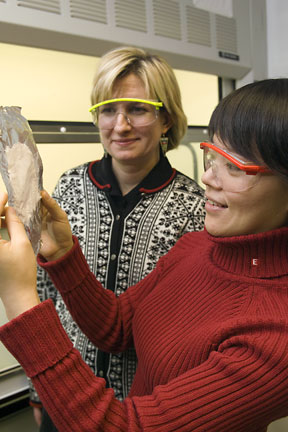Home > Press > New method applies pesticides in nanofibers to keep chemicals on target
 |
| Margaret Frey, left, associate professor of fiber science and apparel design, and research associate Chunhui Xiang have developed a method to deliver pesticides via nanofibers. |
Abstract:
By Sheri Hall: To prevent pesticides from drifting away and potentially posing risks to the environment, Cornell researchers have devised a solution: Apply the pesticides by encapsulating them in biodegradable nanofibers, which keeps then intact until needed and minimizes loss to drift or being washed away from the plants they are intended to protect.
New method applies pesticides in nanofibers to keep chemicals on target
Ithaca, NY | Posted on March 27th, 2009"Our technology will decrease the amount of pesticides applied, which is good for the environment," said research associate Chunhui Xiang, Ph.D. '08, who worked on the new technology with Margaret Frey, associate professor of fiber science and apparel design in the College of Human Ecology, as well as Cornell experts in horticultural sciences and entomology. "All the materials are biodegradable and from renewable resources."
The new technology also extends how long the pesticides remain effective and improves the safety of applications. As the fiber biodegrades, the chemicals are slowly released into the soil.
Xiang, who was named the outstanding student of the American Chemical Society Division for Cellulose and Renewable Materials last year, presented the material at the American Chemical Society annual meeting, March 22-26, in Salt Lake City.
"The chemical is protected, so it won't degrade from being exposed to air and water," Frey said. "It also keeps the chemical where it needs to be and allows it to time-release."
The delivery system is created by electrospinning solutions of cellulose, the pesticide and PLA -- a polymer derived from cornstarch.
For the initial trials, Xiang measured chemical delivery in the laboratory over a 16-week period. The individual fibers tested had a diameter more than 100 times finer than a human hair and could hold up to 50 percent of their weight in agricultural chemicals. The results showed that the chemical was released gradually over the entire four-month period, and that the rate of release could be adjusted by changing the composition of the fiber. The chemical itself did not degrade.
To find out if pesticides delivered this way could really work, professor Michael Hoffmann's entomology group planted 4-by-4 millimeter squares of pesticide-loaded fabrics with pole bean seeds in greenhouses on campus. Pesticide delivered from the fabric effectively controlled white flies on the bean plants.
Meanwhile, professor Alan Taylor's group in horticultural science is investigating use of these fibers to deliver pesticides with seed coating technologies. The team is also considering this system for direct application to plant leaves or stalks.
"It's the tip of the iceberg," Frey said.
This research is funded in part by federal Hatch funds, administered by the Cornell University Agricultural Experiment Station.
Sheri Hall is assistant communications director for the College of Human Ecology.
####
About Cornell University
Once called "the first American university" by educational historian Frederick Rudolph, Cornell University represents a distinctive mix of eminent scholarship and democratic ideals. Adding practical subjects to the classics and admitting qualified students regardless of nationality, race, social circumstance, gender, or religion was quite a departure when Cornell was founded in 1865.
Contacts:
Media Contact:
Nicola Pytell
(607) 254-6236
Cornell Chronicle:
Susan Lang
(607) 255-3613
Copyright © Cornell University
If you have a comment, please Contact us.Issuers of news releases, not 7th Wave, Inc. or Nanotechnology Now, are solely responsible for the accuracy of the content.
| Related News Press |
News and information
![]() Researchers develop molecular qubits that communicate at telecom frequencies October 3rd, 2025
Researchers develop molecular qubits that communicate at telecom frequencies October 3rd, 2025
![]() Next-generation quantum communication October 3rd, 2025
Next-generation quantum communication October 3rd, 2025
![]() "Nanoreactor" cage uses visible light for catalytic and ultra-selective cross-cycloadditions October 3rd, 2025
"Nanoreactor" cage uses visible light for catalytic and ultra-selective cross-cycloadditions October 3rd, 2025
Announcements
![]() Rice membrane extracts lithium from brines with greater speed, less waste October 3rd, 2025
Rice membrane extracts lithium from brines with greater speed, less waste October 3rd, 2025
![]() Researchers develop molecular qubits that communicate at telecom frequencies October 3rd, 2025
Researchers develop molecular qubits that communicate at telecom frequencies October 3rd, 2025
![]() Next-generation quantum communication October 3rd, 2025
Next-generation quantum communication October 3rd, 2025
![]() "Nanoreactor" cage uses visible light for catalytic and ultra-selective cross-cycloadditions October 3rd, 2025
"Nanoreactor" cage uses visible light for catalytic and ultra-selective cross-cycloadditions October 3rd, 2025
Food/Agriculture/Supplements
![]() New imaging approach transforms study of bacterial biofilms August 8th, 2025
New imaging approach transforms study of bacterial biofilms August 8th, 2025
![]() SMART researchers pioneer first-of-its-kind nanosensor for real-time iron detection in plants February 28th, 2025
SMART researchers pioneer first-of-its-kind nanosensor for real-time iron detection in plants February 28th, 2025
![]() Silver nanoparticles: guaranteeing antimicrobial safe-tea November 17th, 2023
Silver nanoparticles: guaranteeing antimicrobial safe-tea November 17th, 2023
Environment
![]() Researchers unveil a groundbreaking clay-based solution to capture carbon dioxide and combat climate change June 6th, 2025
Researchers unveil a groundbreaking clay-based solution to capture carbon dioxide and combat climate change June 6th, 2025
![]() Onion-like nanoparticles found in aircraft exhaust May 14th, 2025
Onion-like nanoparticles found in aircraft exhaust May 14th, 2025
![]() SMART researchers pioneer first-of-its-kind nanosensor for real-time iron detection in plants February 28th, 2025
SMART researchers pioneer first-of-its-kind nanosensor for real-time iron detection in plants February 28th, 2025
|
|
||
|
|
||
| The latest news from around the world, FREE | ||
|
|
||
|
|
||
| Premium Products | ||
|
|
||
|
Only the news you want to read!
Learn More |
||
|
|
||
|
Full-service, expert consulting
Learn More |
||
|
|
||








